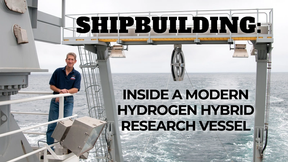In fleeting operations, a towboat operator will frequently perform a maneuver known as "downstreaming," which involves positioning the boat above the fleet, then moving downstream with the current to land on a barge and remove it from the fleet. Typically, downstreaming is a common procedure and normally performed without incident. However, in the past, the maneuver has resulted in a number of vessel sinkings and crew fatalities.
A Quality Action Team (QAT) consisting of USCG representatives, as well as representatives from the Southern Region Quality Steering Committee of the American Waterways Operators (AWO), was formed to study the problem and make recommendations for reducing incidents stemming from downstreaming.
The subsequent analysis showed downstreaming maneuvers were a factor in roughly 1.6 towboat sinkings a year between 1992 and 1996. The QAT identified a total of 15 towboat sinkings from 1990 to 1997, with six of those sinkings resulting in a total of 11 fatalities.
Specifically, downstreaming entails the towboat proceeding upstream above the fleet, before turning downstream - also known as "topping around." The vessel then moves downstream towards the fleet, preferably with the engines in reverse, also known as "backing down." This allows the boat to move toward the barges at a slower speed than the current, idling in place, if necessary. Preferably, flanking rudders are used to hold the boat in position as it approaches the fleet.
The towboat will face up to the barge squarely, deckhands will tie off to the barge and the boat will back out the barge to remove it from the fleet. It should be noted, depending on the fleet location or river stage, this maneuver may be done with little or no current.
However, in a downstreaming casualty, the towboat may have difficulty approaching the barge and facing off to it squarely. If the towboat meets the barge at an angle, and if there is a strong enough current, the boat may become pinned sideways against the barge. In these cases, water may rise up onto the deck and enter the vessel itself through doors or windows. The vessel may capsize and sink, or - if it is pinned under the rakes of the barges - be pulled down under the fleet itself.
Survivors or witnesses have described incidents as happening with surprising speed, with the vessel sinking in less than one minute. Crewmembers unable to climb onto the fleet, or rescue vessels are at extreme risk.
For the study, the QAT identified 15 sinkings that took place between 1990 and 1997. In a number of incidents, the operator was not attempting to downstream, but had simply ventured too close to the head of a fleet and became pinned. Because those incidents were caused by similar factors, and because they provided similar opportunities for a "lessons learned" approach, the QAT included them in the study group.
The group's analysis shows, between 1992 and 1996, 244 towboat sinkings occurred on navigable inland waterways in the U.S. Altogether, eight were related to downstreaming. Another 27 sinkings occurred in the first three quarters of 1997, with three related to downstreaming. Put another way, between 1992 and 1996, the towing industry averaged 48.8 towboat sinkings a year, with an average of 1.6 per year blamed on downstreaming.
While the number of incidents is small, the potential danger to crewmembers is immense. Dating back to 1990, five sinkings resulted in 11 deaths. In two cases, all crewmembers were lost, making it difficult to determine casual factors.
Incidents took place in a number of different areas, but were clustered in St. Louis Harbor and the area between Baton Rouge and New Orleans. Almost universally, the incidents occurred during periods of high current/high river stage. The historic floods of 1993 and 1997 coincided with increases in the number of downstreaming sinkings. The most striking example was in 1997, when three sinkings occurred in the month of March.
With one exception, all the incidents involved towboats with 1,350 hp or less. This is in keeping with the common use of these smaller boats in fleeting of shifting operations
Among the conclusions reached by the QAT were the following:
Smaller towboats operating in swift current conditions are most at risk. The accident history suggests smaller boats with 1350 hp or less are most likely to become involved in a downstreaming incident. This may be attributed to three factors:
·Larger boats are generally powerful enough to avoid becoming pinned against fleets or other fixed facilities.
·Larger boats are more stable, allowing them to survive a pinning incident.
·Most of the work in fleets and at terminals is done by smaller boats, meaning these boats are likely to downstream more often than larger boats.
River current appears to be a critical factor in downstreaming incidents. If human error is the direct cause, a swift current may take away the vessel operator's ability to recover from an error and raises the likelihood a mistake will result in a serious incident.
Further complicating the issue is the fact vessel operators do not normally think in terms of current speed. Operators recognize the effect differing current speeds have on the handling of the vessel, and they do factor that into their decisionmaking, but the actual current speed is not reliably measured or understood.
The other conclusions reached, include the following:
·Human factors, especially complacency and lack of awareness on the part of vessel operators, appear to be the most significant causes of downstreaming incidents and represent the best opportunity to prevent these incidents.
·The most effective way to reduce these casualties is to raise awareness of the risks of downstreaming during high current river conditions. High water and swift current create a number of operational challenges, including increased risk associated with downstreaming.
·Operational measures affect the likelihood and survivability of downstreaming casualties. Where applicable, this includes the use of weather-tight doors and windows and placement of empty barges with box ends upstream.
A vessel with its decks awash in the current is at risk under any circumstance. If this occurs while a towboat is attempting a downstreaming maneuver, the escape options available to that vessel are limited. Ensuring the towboat has adequate freeboard and doors and windows on the deck level are closed and secured are important safety measures for all operations in high current conditions.
If a towboat becomes pinned, crewmembers may have a very short window of time in which to escape from the boat. Crewmembers who are in their quarters or the galley are at especially high risk. Under high current conditions, vessel operators should alert crewmembers whenever they attempt a downstreaming maneuver and position them so they are able to climb to safety in the event of an incident.
Although the QAT made recommendations for not only the wheelhouse personnel and companies, but also the USCG and the USCG, in partnership with the industry, only the recommendations for companies and personnel are detailed below.
For Wheelhouse Personnel:
·Small towboat operators should recognize the risks involved in downstreaming under high current conditions and weigh those risks before attempting to downstream. Downstreaming should not be approached as a "yes" or "no" decision, but rather as a process of continual evaluation, and the vessel operator should be prepared to abort the attempt, if necessary.
·Prior to downstreaming with small towboats under high current conditions, operators should:
-- ensure that doors and windows on the first deck are closed and secured;
-- ensure the boat has adequate freeboard aft;
-- notify crewmembers of his intentions; and,
-- position crewmembers to climb to safty in the event of a downstreaming casualty.
·During periods of high current, vessel operators should manage fleets so as to minimize the need to downstream. This involves managing factors such as the width of the fleet and placement of empty barges so that the box ends face upstream when practical.
For Companies
Companies should support the judgment of the vessel operators and not encourage them to perform any maneuver they are not comfortable with, including downstreaming. Through policy and action, the company should convey the message that crew safety is more important than saving time or gaining financial advantage.
For fleeting companies, a senior captain or other licensed knowledgeable supervisory employee should evaulate newly hired towboat operators to ensure they recognize downstreaming risk factors and understand proper downstreaming procedures for their specific area of operation. If outside towing companies are used within the fleet, the operators of those vessels should undergo a similar evaluation before they are allowed to downstream.
Companies should stress the need for safe operations during periods of high water/high current. Raising awareness as to the risks of downstreaming must be a part of that effort. This involves communicating frequently with vessel personnel in advance, and during the high water period.
Daily crew meetings and communications at watch changes should be used as a means to identify and discuss any downstreaming "close calls" and to determine if additional safety measures are needed.
In advance of high current conditions, companies should work with vessel operators to determine whether downstreaming should be prohibited at specific river stages. This process should draw on the expertise f operators with the best judgment and working knowledge of the area of operation.
High water procedures should address the need to close and secure doors and windows on the first deck and the need to ensure towboats have adequate freeboard aft.
Companies should consider conducting periodic drills to ensure crewmembers understand assigned positions and the proper response to alarms.
Subscribe for
Maritime Reporter E-News
Maritime Reporter E-News is the maritime industry's largest circulation and most authoritative ENews Service, delivered to your Email five times per week













